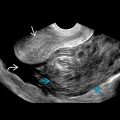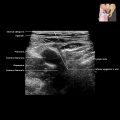KEY FACTS
Imaging
- •
Gallbladder (GB) wall thickening with intramural hyperechoic foci and comet-tail reverberation artifacts
- •
V-shaped comet-tail artifacts from debris in GB wall cystic spaces
- ○
Twinkling artifacts from intramural debris on color Doppler examination
- ○
- •
Morphological patterns: Diffuse, segmental, annular, focal
- •
Annular form: Midbody segmental thickening results in constricting ring around midbody and hourglass shape
- •
Focal fundal adenomyoma
- ○
Smooth fundal solitary intraluminal mass, internal cystic spaces, echogenic foci
- ○
No significant vascularity; ± twinkling artifact
- ○
Top Differential Diagnoses
- •
GB carcinoma
- •
Emphysematous cholecystitis
- •
Chronic cholecystitis
- •
Adenomatous polyp (fundal form)
Pathology
- •
GB wall thickening resulting from epithelial proliferation and muscle hyperplasia leading to formation of intramural diverticula (Rokitansky-Aschoff sinuses) filled with bile, cholesterol crystals, sludge, or calculi
- •
Gallstones in up to 90%
Clinical Issues
- •
9% prevalence in cholecystectomy specimens
- •
F > M; mean age: > 50 years
- •
Most often asymptomatic; or biliary pain/dyspepsia
- •
No conclusive evidence of increased cancer risk
- •
No clinical significance in asymptomatic patients when diagnosed correctly and differentiated from carcinoma
Scanning Tips
- •
Use higher frequency transducer for visualization of comet-tail artifacts and cystic spaces; evaluate GB fundus
 .
.
 . There is a comet-tail artifact associated with an echogenic focus
. There is a comet-tail artifact associated with an echogenic focus  in this patient with fundal adenomyomatosis.
in this patient with fundal adenomyomatosis.
 . There are stones
. There are stones  in the fundus, where the wall is less thick.
in the fundus, where the wall is less thick.
 emanating from debris in Rokitansky-Aschoff sinuses. The sinuses themselves are not visible. Note reverberation artifact
emanating from debris in Rokitansky-Aschoff sinuses. The sinuses themselves are not visible. Note reverberation artifact  from adjacent bowel.
from adjacent bowel.
Stay updated, free articles. Join our Telegram channel

Full access? Get Clinical Tree








